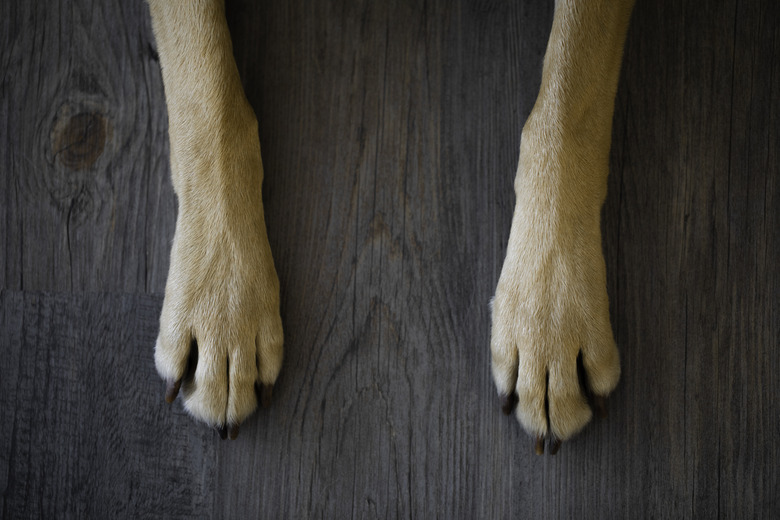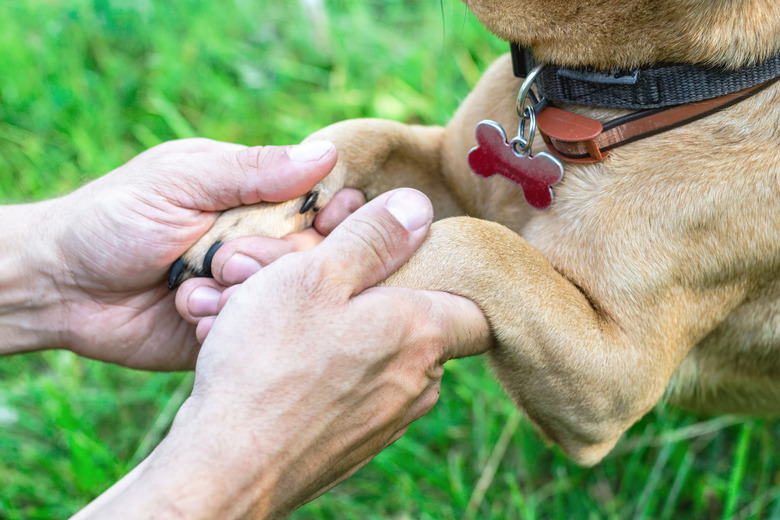Discolored Pads In Dogs
Unless they're causing a beloved canine obvious pain or discomfort, many pet parents don't regularly examine or notice the condition of paw pads. Dogs rely on their footpads for insulation during cold and hot months, to absorb shock from the ground, and to help them with traction during movement. A discolored pad or even a white spot on a dog paw usually means that something is amiss, although the cause may not always be a serious medical issue. That said, keeping an eye on the condition of your dog's paws is an essential part of routine dog health care.
Causes of discolored pads in dogs
Causes of discolored pads in dogs
A dog's paw pads can become discolored for a number of reasons.
- Grass or mud. Because dogs use their paws to get around, regardless of the weather or terrain, they may simply become discolored through environmental exposure, like from grass or mud stains.
- Yeast infection. Sometimes, the hair between and around the paws will take on a reddish-brown or rust color if a dog has a yeast infection, which may also cause paw pads to appear inflamed.
- Saliva stains. If your dog has a skin condition that makes their paws itchy, they might lick at them, which can cause the dog's pads to appear red due to exposure to the dog's saliva.
- Other causes. Red paws can also appear as the result of frostbite, burns, flea dermatitis, or allergies, among other causes.
What if my dog paw pads are white?
If you see dog paw pads turning white, there are several possible explanations.
- Dryness. White crusty pads can appear as the result of dryness or exposure to rock salt.
- Medical causes. More serious conditions, like hyperkeratosis, hookworm dermatitis, hard pad disease, and vitiligo, which is an auto-immune condition, can cause white dog paws.
- Contact dermatitis. Contact pododermatitis occurs when a dog's feet become inflamed as a result of autoimmune disease, hormonal disorders, tumors, cancer, or environmental factors.
- Infection. Additionally, cuts and scrapes can become infected, sometimes leading to discolored lesions.
Depending on the cause of the health condition, you might notice blisters, lesions, or hot spots on your dog's paws.
Treating unhealthy dog paw pads
Treating unhealthy dog paw pads
In order to effectively treat your dog's discolored paw pads, you will need to correctly identify and diagnose the underlying cause. Often, cleaning the affected area with warm water and treating the condition with medication, either systemic or as a topical cream, will address the issue.
Sometimes, certain causes leading to discolored paw pads cannot be cured, such as allergies or immune issues, and preventing recurrence by following a treatment plan from your veterinarian is the best course of action. Your veterinarian can run diagnostics, such as cytology and biopsies, to determine the best course of action, which could include over-the-counter or prescription lotions, supplements, and dog paw balms. If your dog is experiencing lameness or is limping in addition to having discolored paw pads, your veterinarian can look for underlying causes of that as well.
Keeping your dog’s paws safe
Keeping your dog's paws safe
Prevention, when possible, is often the best medicine. Adding paw health to your regular dog care may help reduce the risk of issues that lead to discoloration, or at the very least, it will help you spot discolored feet sooner than later. You should regularly check your dog's paw pads and your dog's nails for foreign objects, swelling, or irritation, especially after going for dog walks. Avoid walking your dog on hot pavement on days with high temperatures and sunny skies and use booties or protective dog paw balm (such as Musher's Secret) on snowy days when your dog may step on rough surfaces, such as rock salt.
Additionally, regular toenail trims can help improve overall paw health. If your dog frequently experiences yeast infections on their paws, be sure to wipe their feet well after coming inside, especially after walking in the rain, and discourage licking of the area.
The bottom line
The bottom line
Whether you're talking about puppies or older dogs, any dog may experience discolored paw pads during their lifetime. Even if it is not a symptom of a serious health condition, the reason for your dog's discolored paw pads could be causing quite a bit of discomfort. Consulting your DVM is always the best thing to do if you notice something different about your dog.


